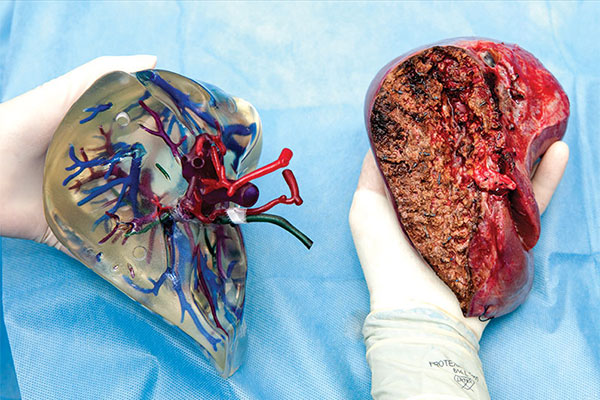
3D printed model liver shows the location of blood
vessels and bile ducts
3D printed models ‘aiding complex surgeries’
CLEVELAND/ABU DHABI, January 28, 2018
Using 3D scanning and printing, surgeons at the Cleveland Clinic are able to plan and practice the procedure of face transplant using accurate, individualized models, significantly improving the outcome for the patient, said a top surgeon.
“A face transplant involves connecting a number of different types of tissue, including bone, muscle and blood vessels, and we not only have to make these function, we have to create a successful fit between the donated face and the patient’s head and neck – all of which are unique,” said Dr Francis Papay. “And of course, unlike a transplanted organ, the results are visible. This face will be the first thing anyone will see when they look at the patient.”
“The more accurate and complete all these connections can be, the better the results in terms of function and appearance.”
Dr Francis Papay will be one of three Cleveland Clinic surgeons to share their experiences of 3D biomodelling during the Arab Health Congress 2018, as part of specialized 3D Medical Printing Conference program.
Others include Dr Nizar Zein, Cleveland Clinic’s Chief of Hepatology and Liver Transplant, and activity director for the 3D printing program within the Arab Health Congress. Also speaking will be Dr Thomas Bartel, who is Section Head of Interventional Cardiology at Cleveland Clinic Abu Dhabi, and has brought the concept to the hospital’s landmark campus in the UAE.
Dr Nizar Zein was among the first physicians to recognize the potential for 3D printing to help reduce the risk of complications during surgery, and more specifically, during surgery on the liver. Starting in 2012, he has led a long-term project at Cleveland Clinic to create 3D printed replicas of individual patients’ livers, accurate enough to use for detailed surgical planning.
“When we operate on the liver, whether removing part of an organ for transplant or carrying out a resection to remove a tumour, one of the biggest risks comes from not knowing the exact locations of major blood vessels or bile ducts, and inadvertently cutting through one of them,” said Dr Zein.
“We typically use a CT scan to come up with a surgical plan for the patient, but there is no sense of depth, and even a 3D scan will still be viewed on a 2D screen. With a 3D printed replica, we solve that problem, and it has the advantage of being tactile – we can pick the model up and examine it in the real world, and reassess our planning based on what we see.”
The models are printed to be transparent, and components within the organ can be printed as separate pieces – held together by magnets – so surgeons can pull them apart and examine them individually. Each model takes about 48 hours to print and is created at actual scale. This is down from around six weeks for the original experimental model in 2012, which was printed at 75 percent of actual size.
As the process has become more refined, the cost has also fallen dramatically, attracting interest from a growing number of physicians. At Cleveland Clinic Abu Dhabi, Dr Thomas Bartel is applying the technology to the heart, seeing potential across a wide range of surgical treatments.
“Particularly where we see a rising number of patients with co-morbidities, current surgical and interventional therapies need individualization,” said Dr Bartel. “3D modelling provides for a much more personalized approach to care for these patients. It can help surgeons choose the least traumatic approach during surgery, which can reduce surgery times and improve recovery post-surgery for those patients most at risk of complications.”
Dr Bartel said 3D printed models could also help improve device-based therapies, by allowing doctors to test the fit of items to be implanted or inserted into the heart. However, Dr Bartel also noted that those benefits must be tested and assessed more thoroughly before 3D printed models become a standard part of a surgeon’s toolkit.
“We are still in an early phase prior to extensive clinical use, and the technology is far apart from becoming a routine approach,” he said. “For the time being, it will rather remain reserved for complex procedures in which standard approaches do not apply.”
The Arab Health Congress will take place at Dubai World Trade Centre from January 29 to February 1, with the 3D Medical Printing Conference held on January 29 and January 30. – TradeArabia News Service







